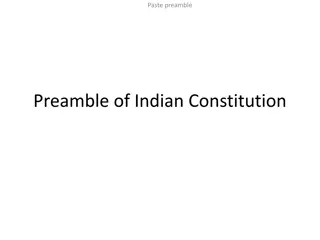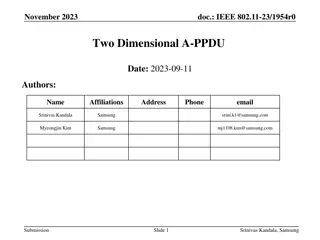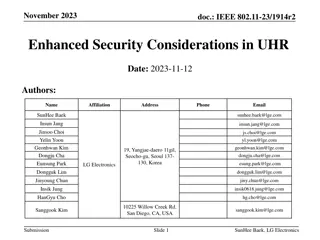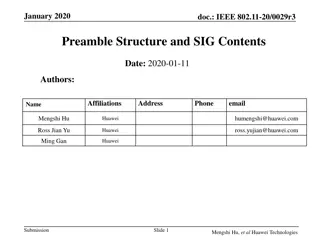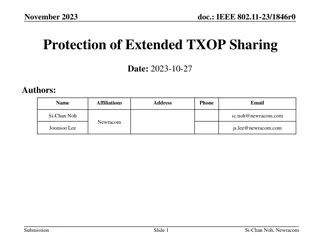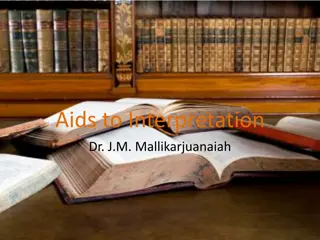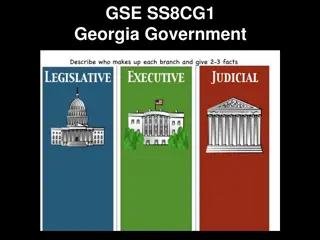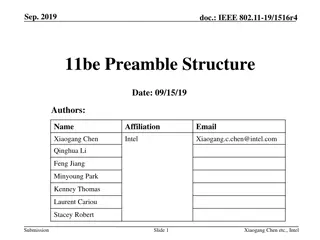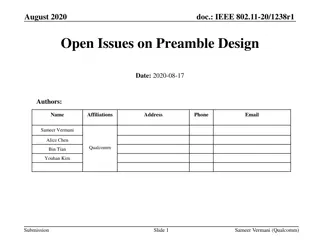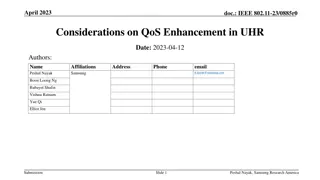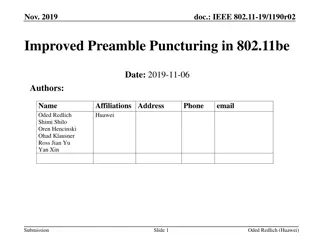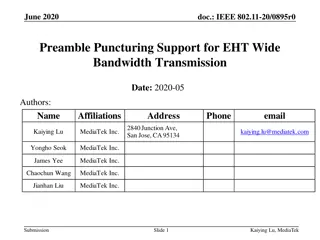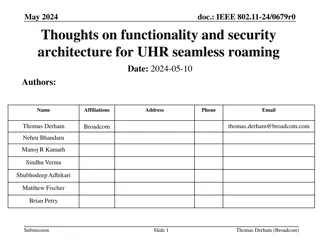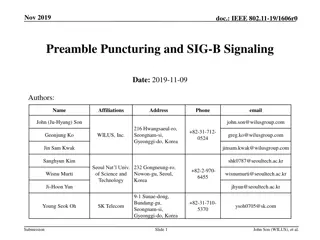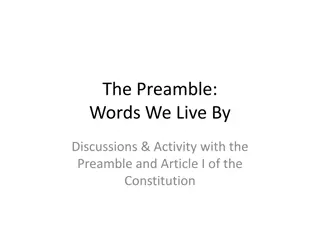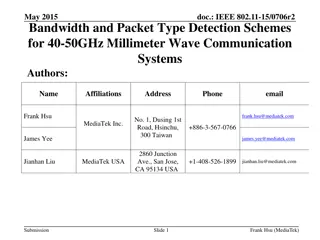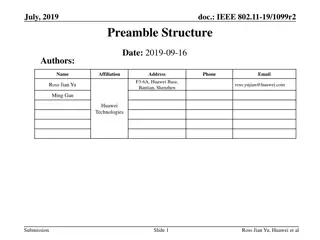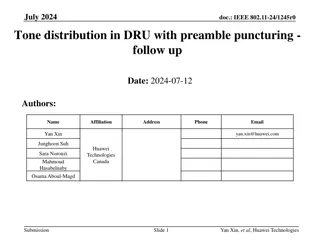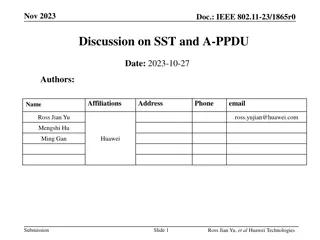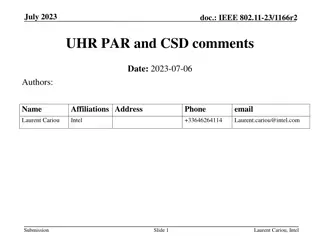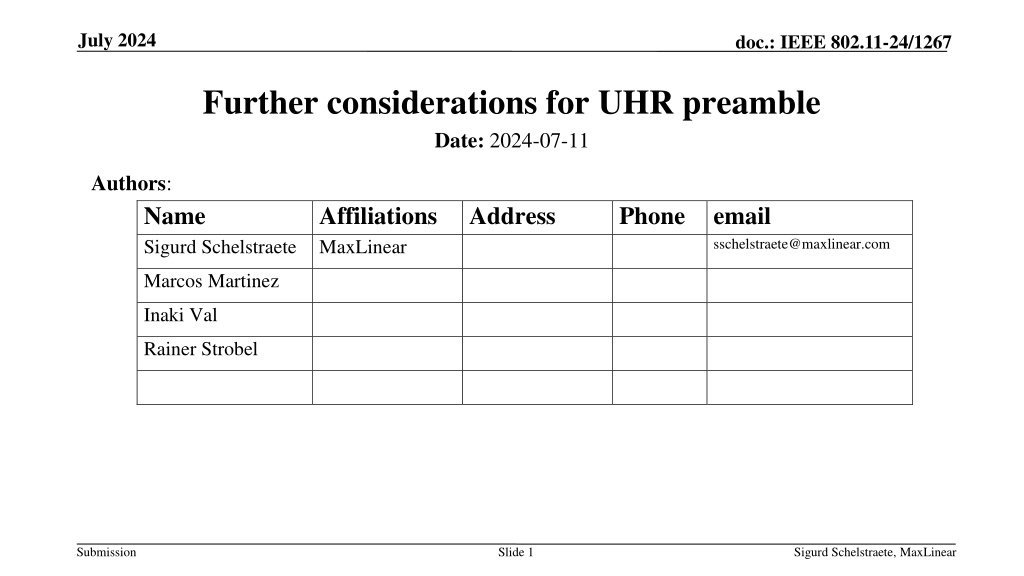
IEEE 802.11-24/1267 UHR Preamble Considerations 2024
Explore the considerations for designing a preamble in IEEE 802.11-24/1267 focusing on accommodating UHR functionality, avoiding duplication, and identifying requirements such as OFDMA support for 11be and 11bn. Delve into the potential mixed mode OFDMA use of 11be and 11bn, discussing advantages like increased efficiency and seamless integration of newer standards. Join the discussion on crucial factors influencing preamble design decisions.
Download Presentation

Please find below an Image/Link to download the presentation.
The content on the website is provided AS IS for your information and personal use only. It may not be sold, licensed, or shared on other websites without obtaining consent from the author. If you encounter any issues during the download, it is possible that the publisher has removed the file from their server.
You are allowed to download the files provided on this website for personal or commercial use, subject to the condition that they are used lawfully. All files are the property of their respective owners.
The content on the website is provided AS IS for your information and personal use only. It may not be sold, licensed, or shared on other websites without obtaining consent from the author.
E N D
Presentation Transcript
July 2024 doc.: IEEE 802.11-24/1267 Further considerations for UHR preamble Date: 2024-07-11 Authors: Name Sigurd Schelstraete MaxLinear Affiliations Address Phone email sschelstraete@maxlinear.com Marcos Martinez Inaki Val Rainer Strobel Submission Slide 1 Sigurd Schelstraete, MaxLinear
July 2024 doc.: IEEE 802.11-24/1267 Introduction Preamble design requires careful consideration Should be able to accommodate all expected functionality (and associated signaling) for UHR Signaling bits in preamble are limited Previous submissions [1, 2] suggested an approach to avoid duplication between EHT and UHR functionality Modes already supported in EHT don t need to be supported in UHR Duplication might lead to extra testing time and confusion in deployment Other submissions [3] prioritize simplicity over avoidance of duplication New PHY Version ID for all UHR transmissions Submission Slide 2 Sigurd Schelstraete, MaxLinear
July 2024 doc.: IEEE 802.11-24/1267 Purpose of submission Have we identified all the requirements for UHR preamble? Invite further discussion on required functionalities before locking down preamble design Ways to avoid duplication (if desired) is not the only factor This submission looks at possible requirements that could impact preamble design Specifically: OFDMA support for 11be and 11bn Invite others to formulate additional requirements (if any e.g. LR, ) to allow for well- informed decision on preamble design Submission Slide 3 Sigurd Schelstraete, MaxLinear
July 2024 doc.: IEEE 802.11-24/1267 11be/11bn mixed mode OFDMA One issue that would impact preamble design is whether we envision mixed use of 11be and 11bn in OFDMA I.e., a mode where a single (DL or UL) OFDMA transmission addresses a mix of 11be and 11bn capable STAs simultaneously There is an interest in combined use of different 802.11 generations See: A-PPDU proposals [4] Proposed for 11bn/11ax mix Native support for 11bn/11be mix would be simpler No dependence on SST, DSO, Existing UL OFDMA does not appear to prohibit a mix of 11ax and 11be user info fields Trigger frame sent in legacy format No support for mixed DL OFDMA Submission Slide 4 Sigurd Schelstraete, MaxLinear
July 2024 doc.: IEEE 802.11-24/1267 11be/11bn mixed mode OFDMA (2) Being able to address both 11be and 11bn offers advantages: Increased efficiency (as opposed to having to partition 11be and 11bn STAs in separate groups) More seamless introduction of 11bn (AP) in legacy-11be (STA) deployment Submission Slide 5 Sigurd Schelstraete, MaxLinear
July 2024 doc.: IEEE 802.11-24/1267 Impact on preamble design Such a (DL) OFDMA transmission would have to meet a number of constraints: Be fully processed by both 11be and 11bn STAs Can not cause early termination for either type of STA Preamble changes after U-SIG (if any) should be transparent to 11be devices 11be devices should be able to parse preamble or at least the parts relevant for the 11be device In particular, 11be devices should see compatible EHT-SIG User Info fields could be identical for 11be and 11bn devices, or a new 11bn format could be defined for the User Info field Clearly, support of mixed 11be/11bn OFDMA mode would require careful consideration of preamble design Submission Slide 6 Sigurd Schelstraete, MaxLinear
July 2024 doc.: IEEE 802.11-24/1267 Conclusion We presented additional considerations that could impact preamble design One such issue is the support of mixed 11be/11bn OFDMA transmissions This and other requirements need to be decided before making fundamental choices in preamble design Submission Slide 7 Sigurd Schelstraete, MaxLinear
July 2024 doc.: IEEE 802.11-24/1267 Straw Poll SP1: Do you agree to include the following text to the 11bn SFD? UHR shall have the ability to address a mix of EHT and UHR STAs in a single OFDMA transmission (UL or DL) Submission Slide 8 Sigurd Schelstraete, MaxLinear
July 2024 doc.: IEEE 802.11-24/1267 References [1] UHR preamble design options , IEEE 802.11-24/0428 [2] UHR preamble design follow-up , IEEE 802.11-24/0774 [3] UHR PPDU PHY Version, IEEE 802.11-24/0876 [4] Discussion on A-PPDU follow-up, IEEE 802.11-24/0224 Submission Slide 9 Sigurd Schelstraete, MaxLinear


